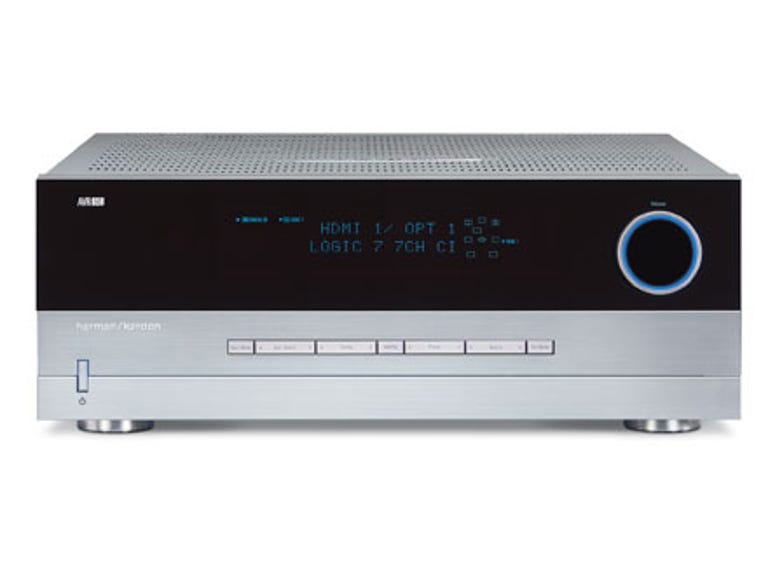 Why You Can Trust CNET
Why You Can Trust CNET Harman Kardon AVR 645 review: Harman Kardon AVR 645
Not the most straightforward amp to use, but get the settings right, and the Harman Kardon AVR 645 rewards you with a rich home theatre experience.
Harman Kardon are probably not a brand mentioned in the same breath as Sony, Pioneer or even Denon. Because like another brand formed in the US, Marantz, HK are a semi-specialist manufacturer, and are credited as helping to create the hi-fi industry we know today.
The Good
The Bad
The Bottom Line
Though they still produce hi-fi equipment, the company has followed the industry trend and concentrates on producing home theatre gear. The AVR 645 is one of their latest models, and it remains up to date by including features such as HDMI up-conversion and iPod compatibility.
Design
The AVR 645 shares the look that HK has used since the release of its Jubilee range in 2003 -- which celebrated the 50th anniversary of the company's first receiver. It's a stylish finish, with its distinctive "neon egg ring" volume knob and piano-black front panel. It's a sturdy machine mostly, and the back panel is particularly well laid-out, with plenty of breathing space if you need to add new components. However, the build isn't as impressive as rivals, as the volume knob feels plasticky, and the plastic flap at the front bends when you put pressure on it. Not nearly as classy as the damped aluminium doors of the Pioneer and Marantz.
Features
For iPod fans, there is an optional attachment, called, quite theatrically, "The Bridge" and is available for an extra AU$99. Unfortunately, it wasn't included in the package so we were unable to test it.
Performance
Initially, we found the sound via the stereo inputs and the onboard digital converter alike to be a lot less punchy than competitive models. There seemed to be a distinct lack of bass on our test JBL L890's, and too much emphasis on the high frequency stuff. The JBL's twin tweeters only compounded the issue.
It was only with some investigation that we found the problem was with the EQ -- it had been preset with nothing on the front panel informing us that it was even activated. There isn't even a "Source Direct" mode on the remote or front panel to defeat the EQ.
We turned to the manual and that was perhaps our first hurdle. The manual is terrible -- it's wordy, with very few diagrams, and quite difficult to find what you want. For example, it takes 40 pages before it gets to "Basic operation", and how to turn the thing on!
Operation is via the onscreen display (OSD), but we did have some problems with our Sony TV recognising the OSD -- an HDMI handshake problem we suppose -- and we needed to change to component output to view it. It's from the OSD that you can access the EZSet EQ, and you'll be glad you did. The initial problems we had disappeared instantly. This is a very comprehensive set-up routine, and with it came dynamics, bite and authority. The sound it produced was equally proficient at stereo music and surround sound. That's not to say that you need it, as the unequalised sound still sounds okay, but nowhere near as thrilling as the optimised version.
CDs, which at first had sounded brittle and distant without equalisation, burst from the speakers, and while it won't serve music as well as an amp like the Marantz SR7001, it still did a sterling job.
Our test disk of King Kong was equally impressive, with both video and audio involving and powerful. The only drawback is that the amp won't upscale video to HD like its rival the Pioneer, and the partnering Harman Kardon DVD 37 uses a lesser, no-name upscaler. The result was still home cinema worthy though.
One bonus for Windows Media Center buffs is the inclusion of a USB port, which enables the HK to act as a sound card while also enabling basic transport control (play, pause, etc) via the remote. The facility works OK, but using Windows Vista we were unable to get the play controls to function. We had to press the USB source button numerous times before it would recognise it, and most times it would simply revert to DVD transport.
With the USB input, there is also a short silence during the start of each song as the digital converter recognises the format and converts it. We would have preferred an Ethernet connection instead of USB, as using HK's method still necessitates a computer in the lounge room. But, either way, connecting via optical/coaxial digital will still use the onboard digital converter, and be more flexible to boot.


